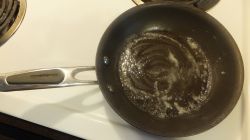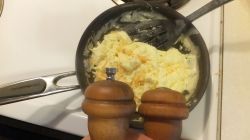Making Great Scrambled Eggs
Improving Scrambled Eggs, one breakfast at a time
Scrambled eggs are found on almost every breakfast table during the week, sometimes multiple times. They aren't technically "hard" to make, but good (great?) scrambled eggs are harder to come by. Myself, my wife, and my 3 sons all eat scrambled eggs. I have what I feel to be pretty darn good recipe, which I would like to share with you. My middle son is especially picky, so I had to get the recipe just right!
Making scrambled eggs in this way takes a little more preparation than normal, but not much. Once you get the recipe down, it becomes second nature.

Pan selection
This is more important than you think!
For this recipe, we are going to pick the pan on the left, an 8 inch frying pan. The one in the middle would work as well, but I have found the smaller pan is best. The square griddle on the right side doesn't work as well, because it allows the eggs to spread out more, causing a more flat final product, not big and fluffy eggs. It would be good for making pancakes, or french toast.
The medium pan would work, but still allows the eggs to spread around a bit too much. If you were in a hurry, you could cook eggs quicker on the medium pan or large griddle, but they would not come out as tasty.
The smaller, 8 inch skillet on the left happens to be my dedicated egg pan because it works so well. It has certainly seen better days, but still works great.

Pre-heat your Pan
You want to pre-heat your pan. Ranges vary, but a medium to medium high heat is best. Too hot and you will burn your eggs. Too low and they won't even cook!
Add a bit of butter. Maybe half of a tablespoon. Enough that once it melts it will cover the entire bottom of the pan.
I've attempted using olive oil, canola, and other oils. I've found butter works best for me, but you can experiment and try different kinds.
Add whatever mix-ins you like...diced peppers, onion, spinach. Don't add the cheese yet!

Cracking the egg
Usually I make 2 to 4 eggs in batches, to allow for even cooking. More than that and you risk not being able to cook your eggs throughout. Less is not really worth the time!
I find that if you hold the egg in one hand with a loose grip(like a small baseball) that you can crack the egg and control both halves. You can then use both hands to peel the eggshell apart. Now is the time to separate the white from the yolk if you prefer, but I use the whole egg most of the time.

Watch the butter!
Watch the butter in your pan. If it spreads out and gets foamy, maybe a little shimmery, then it is time to cook your eggs.
If you tilt the pan a little, the melted butter should slowly roll down the base of the pan. If it sloshes around quickly like water then the butter was heated too much. Discard it and start over. You may need to allow the pan to cool and work on a different jet.

Add liquid
You want to add some sort of liquid to the egg to keep the finished eggs from drying out. I generally use water, but any kind of milk or even heavy cream will work. White wine can also work. Try using a dollop of sour cream!
This can sometimes be a little tricky. Add too much and the eggs will be a little wet, even when fully cooked. Add too little milk and you risk dry eggs.

Scramble your eggs
I prefer the boat motor to the whisk. Whisking makes it a little harder to incorporate the milk properly, and gives a marbled appearance. You may want to use a clear, larger bowl to scramble your eggs, as this allows more wrist action.
The boat motor gives a uniform, yellow color and incorporates the milk very well. You can usually fit your boat motor right into the mug you've used to crack and hold your eggs/milk. Try to use the low setting to incorporate it, as if you use high then the eggs may splash up the sides(and out onto your counter top).


Keep it moving!
Use a spatula to keep your eggs moving. If you allow them to sit, they might brown on the bottom. I tend to grip pretty close to the turning part of the spatula, as opposed to further down the handle. You are more pushing the eggs around for even cooking as opposed to a "flipping" action here. They will simply be too wet to flip right now.

Add your cheese
Add cheese, if you want. I prefer sharp cheddar, my kids and wife like white American cheese.
Keep the eggs moving! They should start to become more solid now. About 50% sold/50% wet.

Fresh cracked pepper, salt
I like to salt and pepper my eggs just before they are done, so that it incorporates into the mixture. Fresh cracked peppercorns are a real treat compared to the pre-cracked powdered kind.
Powdered pepper contains stems and other parts of the plant, which is what makes you sneeze. Fresh cracked peppercorns don't bother my nose at all!
This salt and pepper mill were a gift from my grandfather to my grandmother. She loved fresh cracked pepper as well.

Plate your eggs and Eat!
Now that your eggs are mostly cooked, give them a good flip using the spatula and make sure they are cooked through.
If so, plate them up and eat.
Breakfast is served!
This content is accurate and true to the best of the author’s knowledge and is not meant to substitute for formal and individualized advice from a qualified professional.








